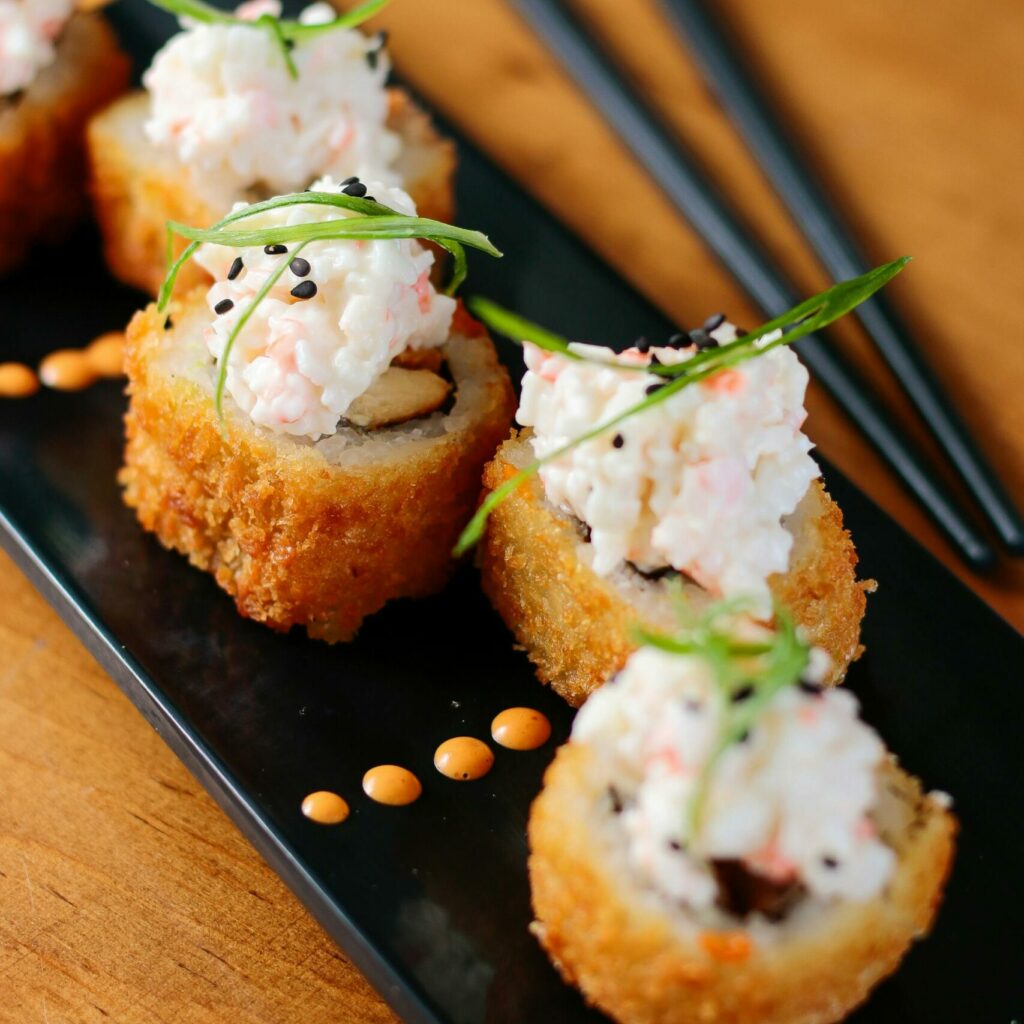The world of Sushi is constantly evolving, combining age-old tradition with contemporary innovation. In 2025, the Japanese cuisine is undergoing a profound transformation, driven by new consumer expectations and remarkable technological advances. Let's find out more about new trends redefining the Sushi and are revolutionising Japanese restaurants.
Rethinking traditional dishes
Sushi panko
Le Sushi Panko is made in the same way as traditional Sushi, except for one step. Once you've made your Sushi, Maki or California, all you have to do is cover it with golden breadcrumbs and light, the pankoand fry lightly.
Today, the Sushi Panko has become a staple on sushi menus. As well as its golden visual appeal, which meets the expectations of increasingly Instagrammable products, the breading adds a touch of class to the product. crispy at Sushi and therefore different textures throughout the tasting experience. It's an ideal way of responding to new consumer demands, while retaining the quality of the product.the very essence of traditional Sushi.
Tempura reinvented
This Japanese dish of breaded and fried seafood, chicken or vegetables is being reinvented using innovative ingredients. Chefs are trying to adapt this dish by using fresh fruit or by turning it into dessert. La tempura ice cream is a perfect example. A scoop of ice cream is coated with a light, crispy batter, then quickly fried to create a warm, crispy crust. This surprising combination creates a a playful, contrasting mix of flavours and textures.
A commitment to the environment
Responsible consumption
For a number of years now, the trend has been towards more responsible consumptionand Sushi are no exception. This more responsible and environmentally-friendly consumption is encouraging people to favour local productsof season and chemical-free.
Japanese restaurant chefs are opting for more sustainable practices and adapting their recipes according to the seasons and produce available in their region. This cuisine is accompanied by awareness campaigns to reduce our carbon footprint but also to protect certain endangered species, such as fish.
Plant-based alternatives
To find out more about sustainable practicesthe Sushi are becoming increasingly popular. They offer creative alternatives and can be adapted to suit diets (vegetarians and vegans), but also to the curious. These creations are opening up new markets and proving that theadaptability of an establishment.
Automation
The Japanese cuisine is undergoing a technological revolution. To meet the strong demand for Sushiand a range of dishes that are becoming increasingly popular, establishments are equipping themselves with machines to accompany their chefs. In this way, they can offer their customers regular products, produced with precision and to the required deadlines. This automation is a response to several of today's major challenges: labour shortages, variations in the quality of dishes, strong demand, optimisation of production costs, etc.
Reinventing the customer experience
Personalised offers
For enhancing customer valuesome establishments are opting for personalisation of their offer. In this way, service is no longer the only aspect that enhances the customer's experience, but the way the dish is prepared, the ingredients used and even the décor all play a key role.
For exampleOmakase is an increasingly popular experience. This expression, which means "I leave it up to you", is used to ask the head of a company to make a decision. surprise your guests by creating an original dish that is not on the menu.
Tasting menus
The tasting menus are becoming increasingly popular, especially for the Japanese cuisine. This approach allows you to discover numerous recipes and can be a source of learning about the ingredients and techniques used. It's also a perfect way to introduce more contemporary dishes or adaptations that can sometimes be frightening. A perfect way to combine the discovery of traditional know-how at modern adaptations.
The future of Sushi is taking shape today
The year 2025 marks a decisive turning point for the Sushi. Between bold culinary innovations, ecological commitment and technological revolution, Japanese restaurants are redefining their standards of excellence. For professionals in the sector, embracing these new trends is essential if they are to remain competitive in a rapidly changing market.
The combination of Japanese tradition and modern innovation opens up an infinite range of possibilities, promising sushi lovers ever more surprising and environmentally-friendly taste experiences.


